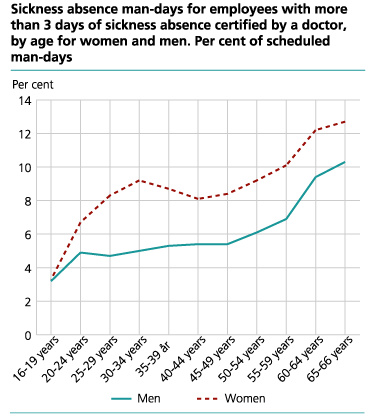Content
Published:
This is an archived release.
Sickness absence increased
The sickness absence rate increased from 6.5 to 7.0 per cent from the first quarter of 2001 to the first quarter of 2002. Women of aged 25-39 had a particularly strong increase of the sickness absence rate last year
Adjusting for the fact that Easter fell in the first quarter in 2002 and in the second quarter in 2001 would have resulted in an approximately 0.2 percentage points lower increase of the sickness absence rate.
The sickness absence rate shows the number of man-days lost due to sickness absence as a percentage of all scheduled man-days. This takes into account both full-time and part-time employees and whether the person is on full or partial sick leave. The statistics include employees with sickness absence of more than 3 days with a doctor's certificate. Statistics Norway and the National Insurance Administration (RTV) produce the statistics.
In this article we comment on figures where Easter is included in the first quarter of 2002. Without Easter the sickness absence rate would have been 0.1-0.2 percentage points lower for most groups.
Strongest increase in sickness absence among elderly employees and among young women
The total sickness absence rate increased by 0.5 percentage points from the first quarter 2001 to first quarter 2002.The increase was 1.3 percentage points among employees aged 65-66. Women in the age groups of 25-29, 30-34 and 35-39 had an increase of sickness absence by 0.7 - 0.8 percentage points last year. Men in the corresponding age groups had an increase of sickness absence of only 0.3 - 0.4 percentage points in the corresponding period.
Health and social work has the highest level of absence, decrease in Electricity, gas and water supply
Health and social work has the highest level of sickness absence with a sickness absence rate of 9,4.
The sickness absence rate for the group Electricity, gas and water supply decreased by 0.2 percentage points from the first quarter 2001 to the first quarter 2002. The industries Mining, Oil- and gas extraction and Financial intermediation had small increases in the sickness absence rate, 0.1 -0.2 percentage points respectively. Among the main industries such as Construction, Retail trade and Hotels and restaurants had large the increases were 0.7-0.8 percentage points.
Figures for the municipal level now available
This time the sickness absence statistics introduce tables showing the sickness absence rate for all municipalities. Please note that the figures for sickness absence by region are given for the region of residence, not for the region of work place.
Tables
The statistics is published with Sickness absence.

